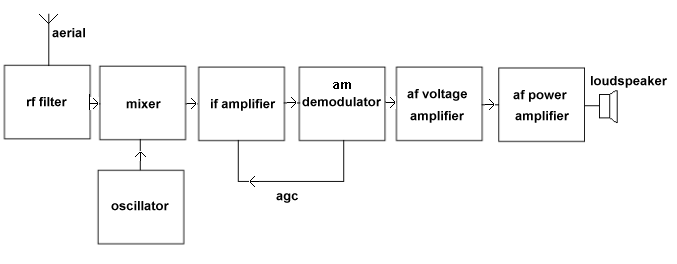Most of these
blocks are discussed individually, and in more detail, on other pages.
See filters,
mixers, frequency changers, am modulation and amplifiers.
There are signals
from thousands of radio transmitters on many different frequencies inducing
signal voltages in the aerial.
The rf filter
selects the desired station from the many.
It is adjustable
so that the selection frequency can be altered.
This is called
TUNING.
The selected
frequency is applied to the mixer.
The output of
an oscillator is also applied to the mixer.
The mixer and
oscillator form a FREQUENCY CHANGER circuit.
The output from
the mixer is the intermediate frequency (i.f.)
The i.f. is
a fixed frequency of about 455 kHz.
No matter what
the frequency of the selected radio station is, the i.f. is always 455
kHz.
The i.f. signal
is fed into the i.f. amplifier.
The advantage
of the i.f. amplifier is that its frequency and bandwidth are fixed, no
matter what the frequency of the incoming signal is.
This makes the
design and operation of the amplifier much simpler.
The amplified
i.f. signal is fed to the demodulator.
This circuit
recovers the audio signal and discards the r.f. carrier.
It usually incorporates
a diode in the circuit.
Some of the audio
is fed back to the i.f. amplifier as an AUTOMATIC GAIN CONTROL voltage.
This ensures
that when tuning from a weak station to a strong one, the loudness from
the loudspeaker stays the same.
The audio signal
voltage is increased in amplitude by a voltage amplifier.
The power level
is increased sufficiently to drive the loudspeaker by the power amplifier. |

